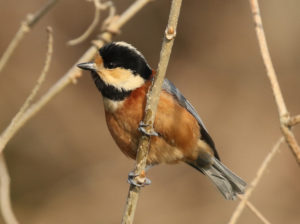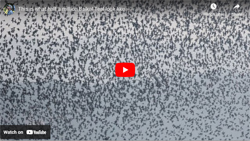South Korea Winter Birding Tour
 3rd-15th January 2025: South Korea winter birding highlights include Steller’s Sea Eagle, Red-crowned Crane, Baikal Teal, Relict Gull, Asian Rosy Finch, White-naped Crane, Varied Tit, Swan Goose, Spectacled Guillemot, Scaly-sided Merganser, Hooded Crane, Oriental Stork, Chinese Grey Shrike, Stejneger’s Scoter, Japanese Wagtail, Long-billed Plover, Rhinoceros Auklet & Solitary Snipe – £3950 per person.
3rd-15th January 2025: South Korea winter birding highlights include Steller’s Sea Eagle, Red-crowned Crane, Baikal Teal, Relict Gull, Asian Rosy Finch, White-naped Crane, Varied Tit, Swan Goose, Spectacled Guillemot, Scaly-sided Merganser, Hooded Crane, Oriental Stork, Chinese Grey Shrike, Stejneger’s Scoter, Japanese Wagtail, Long-billed Plover, Rhinoceros Auklet & Solitary Snipe – £3950 per person.

Trip Details
- Dates: 3-15th January 2025
- Cost: £3950
- Single Supplement: None
- Deposit: £560
- Tour length: 13 Days (11 days birding)
- Min/Max group size: 4 / 9
- Start/Finish: Seoul
- Tour Type: Birding
- Photo Opps: Very good
- Physical Classification: Easy
- Tour Leaders: Nick Upton & Dr Nial Moores
If you have any questions about this trip, please feel free to contact us at info@calidrisbirdingtours.com
South Korea Birding in Winter
Set among snowy mountains, pine forests, river estuaries, agriculture and wetlands, coastal villages and seascapes South Korea winter birding is an experience that reminds birders that there are still places where birds exist in large numbers. Imagine flocks of cranes amassing to feed in rice fields, rafts of alcids in the sea, more gulls on one beach than should be able to fit on it, groups of Cinereous Vultures loafing around waiting for food, woodlands full of flocks of small birds, skeins of geese cruising through the sky and lakes filled with flocks of wildfowl in the tens of thousands in number. You may not have thought of visiting South Korea before but this is some of the best birding in East Asia, a bit of a secret location for finding some of the most sought-after species of the region.
The Republic of Korea (South Korea) is at the southern tip of the Korean peninsula, separated from China by North Korea and from Japan by the East Sea. This is a country that few birders visit, usually overlooking it for trips to Japan and China. However, due to its small size and excellent infrastructure it is easy to cover the whole of the mainland of South Korea quickly, easily and relatively cheaply in order to see a superb selection of wintering birds. Well-organized and safe, there is no history of bird persecution in South Korea meaning that birds occur in good numbers at almost any location. Although there is not a huge bird list to gain on a winter birding trip to South Korea, what you do get is quality and repeated good views of most species instead of glimpses of species that never reappear.
For those that want to see large numbers of birds, this is where you can get your fix. This is also a great opportunity to learn about the birds you see, and the conservation issues that affect them, with our extremely knowledgeable guides. This is a trip for those who really love observing birds but also for those who wish to connect with species such as Red-crowned Crane, Steller’s Sea Eagle, White-naped Crane, Baikal Teal, Scaly-sided Merganser, Hooded Crane and Relict Gull. For those who enjoy gulls South Korea winter birding is something you must experience with some truly spectacular numbers and a great variety along the north east coast. For those who like woodland birds then Japanese Pygmy Woodpecker, Varied Tit and White-backed Woodpecker are going to excite you; variety is a strength of this tour as well as scale of numbers and rarity.
Day 1, Arrival in Seoul – 3rd January 2025
Planned arrival time is around mid-morning to midday on 3rd January at Incheon International Airport. You will be met here by your guides and taken to check-in at a nearby hotel. In the evening the group will have dinner together and receive a pre-trip briefing on South Korea winter birding. A good night’s sleep in a comfortable hotel will ensure everyone is able to enjoy the first day’s birding to the full without being too tired – there are some really good birds to come right from the start!
Day 2, National Arboretum – Jeongok – 4th January 2025
After breakfast we will drive around an hour and a half to the national arboretum, close to Seoul. The journey will introduce us to not only some of the impressive rocky mountain scenery of the country but also to some of the massive infrastructure projects that have forged the modern Republic of Korea.
The arboretum is a picturesque place for us to enjoy our first birding of the trip and it is particularly pretty if there is a covering of snow. Birding around the lovely gardens and open woodland creates a pleasant pace for the first day and we can enjoy seeing our first Brown-cheeked Bulbuls, Eastern Great Tits and Vinous-throated Parrotbills of the trip. We also expect to see the stunning Varied Tit, a bird that is a wonderful welcome to birding in South Korea. The regionally endemic Japanese Pygmy Woodpecker is often a friendly bird here, finding us before we find it, while we will also expect to see White-backed Woodpecker. The distinctive doerriesi subspecies of Grey-capped Pygmy Woodpecker exists in small numbers here and we may be able to find one with luck.
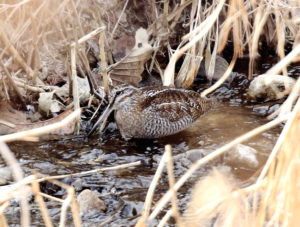
Other woodland birds we will expect to see as we stroll around include Coal Tit, Eurasian Nuthatch, Daurian Redstart, Hawfinch, Yellow-throated Bunting, Marsh Tit and Great Spotted Woodpecker. It will be relatively easy to catch up with most of these species but a few other rarer species that we have a chance to see here include the impressive Black Woodpecker, Naumann’s Thrush, Pallas’s Rosefinch and Yellow-bellied Tit if it has been an invasion year for this colourful little bird.
However, the main reason to visit this site is to check the stream that runs through the arboretum for Solitary Snipe, a bird that is very difficult to see throughout most of its range. This cryptic but surprisingly attractive species will be our main focus here and has been reliable on previous visits. It is possible that we will find Green Sandpiper in the stream too along with our first Eastern Spot-billed Ducks and perhaps some colourful Mandarin Ducks. This will certainly be a bird-filled start to our trip, with plenty of photo opportunities for those with a camera.
By mid-afternoon we will head towards the town of Jeongkok to visit a site for Eurasian Eagle Owl where it often perches on low cliffs alongside a river. There are other possibilities to finish our day with here too with Northern Goshawk and Eurasian Sparrowhawk regular visitors while the river can hold Japanese Wagtail, Goosander and Green Sandpiper. On previous visits we have found Meadow Bunting as well as Amur Leopard Cat here.
Day 3, Cheorwon – 5th January 2025
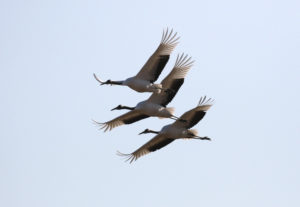
We will be up early for breakfast in a steamy restaurant before heading to our view point for something truly spectacular. Standing on a small hill, which is the site of a war memorial, we will await one of the most memorable birding spectacles of the trip; the flypast of the cranes! As the sun rises small numbers of cranes will emerge from the Demilitarized Zone; the border with North Korea. Here the cranes roost in hot springs, and come flying in to feed in the stubble fields of the Cheorwon Plain, on the South Korean side of the border. At first there will be groups of three to five Red-crowned Cranes and White-naped Cranes but the numbers will build into the hundreds and some birds will come so close to use that it will feel like we can pluck them from the air. Although this area has an obvious military presence it is safe to visit and being able to view the cranes in flight with border fortifications in the background adds to this fantastic experience. For birders this is a unique opportunity to study these graceful birds in flight at close quarters. If you are a photographer then make sure you bring a big memory card! This is South Korea winter birding at its best.

By spending time in this area we can look for wildfowl feeding in the fields too with large flocks of White-fronted, Taiga & Tundra Bean Geese usually present and the chance of finding Lesser White-fronted Goose among them. We may also see our first Baikal Teal here while soaring in the skies we can appreciate massive Cinereous Vultures at close range (a flock of over 400 birds were present in 2017) .
We also have a chance of finding Sandhill, Hooded and Common Cranes in this area, all of which regularly winter in the area in small numbers. There is also a chance of being able to enter a restricted area where 1-3 Siberian Cranes have annually wintered since 2010; a sighting of this critically endangered and beautiful bird would certainly be a highlight of the day*.
Birding around the fields and copses in this area could prove interesting for passerines with flocks of Rustic and Yellow-throated Buntings, Brambling and Oriental Greenfinch quite common, emerging to feed on spilt grains. Perhaps we might find a rarer species foraging alongside them – Black-faced, Chestnut-eared or Meadow Bunting? Within these rough margins of the farmland we can also find Bull-headed Shrike, Daurian Redstart, Hawfinch and it is here that we have our first chance to find Chinese Grey Shrike and Long-tailed Rosefinch if we are lucky. The supporting cast will include cute little Long-tailed Tits, Eastern Great Tit, Oriental Turtle Dove and Brown-cheeked Bulbul.
*In winter 2015, 2017 & 2019 access was permitted but in winter 2016 it was not.
Day 4, Paldang – 6th January 2025
A drive of around an hour or so will see us arrive on the banks of the Han river at Paldang. This is an interesting birding site where wildfowl and raptors congregate on a wide river, with rocky islets and rough vegetation alongside in which a nice selection of passerines can be found. Set within an urban area but also surrounded by mountains, which are often snow-capped in winter, this location provides us with some memorable vistas as well as some memorable birds, the most highly-anticipated of which is Steller’s Sea Eagle. Two to four of these magnificent raptors regularly winter here, frequently harassing White-tailed Eagles on the iced edges of the river. We should be in place in time to see them arrive from their roost site and we will make every effort to get the best views that we can get here.
In the river there will be flocks of Whooper Swans, Goldeneye, Goosander and Eastern Spotbilled Duck but what we will be looking out for are the Scaly-sided Mergansers that often spend the winter here. Females/juveniles usually outnumber the males but we expect to locate several of these handsome birds with their wild crests and finely-patterned flanks.
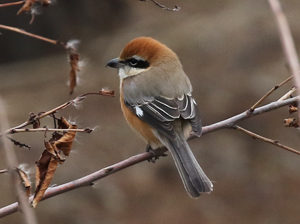
Lots of other species of wildfowl are expected here with Northern Shoveler, Common Pochard, Northern Pintail, Eurasian Teal and small numbers of super Falcated Duck. Those who wish to add non-feral Mandarin Duck to their list can surely do so here.
Along the banks of the river at Paldang are areas of rough scrub and fringing trees which play host to plenty of birds of interest too, including the very smart Siberian Accentor in small numbers. Vinous-throated Parrotbills are abundant as are Eastern Great Tits and Oriental Turtle Doves but scarcer species can include Meadow Bunting or Long-tailed Rosefinch. Yellow-throated and Rustic Buntings usually feed on fallen weed seeds and Daurian Redstart is usually quite common too. Birding along here we can probably see more Bull-headed Shrikes, Brambling and possibly flocks of Azure-winged Magpies while there is always the chance of a South Korean rarity too.
As well as Steller’s Sea Eagle and White-tailed Eagle this is a good spot for other raptors too. Eastern Buzzard is common throughout the country and Northern Goshawk, Eurasian Sparrowhawk and Peregrine Falcon are frequent here. Rough-legged Buzzard is possible too.
Day 5, Namhansanseong – YangYang – Daejin – 7th January 2025
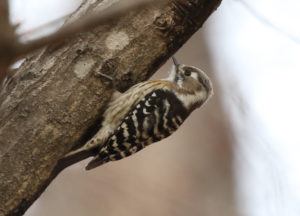
Starting the day in the forested hills of Namhansanseong will provide us with a different type of birding than the previous day. While we can enjoy more views of the lovely Varied Tit our main target here is Hazel Grouse, a widespread but seldom-seen bird. By walking slowly through the woodland, listening carefully for the sound of Hazel Grouse moving around in the early morning, or perhaps making their high-pitched whistling sound, we hope to locate these intricately-marked birds in an area where we have regularly had success in the past.
Other woodland birds we see here are likely to include Eurasian Nuthatch, White-backed Woodpecker, Marsh Tit, Eurasian Jay, Japanese Pygmy Woodpecker and perhaps Grey-headed Woodpecker. Small groups of Naumann’s Thrush have also been a feature here on past visits, basking in the early morning sun. If this is a year with a lot of snow on the ground then we might experience an influx of migrant species with rare birds such as Japanese Waxwing or Pallas’s Rosefinch possible.
After enjoying a few hours here we then plan to drive across country to the strangely-named town of Yangyang. Although the river here is quite disturbed there are areas where we can find birds that like the wet margins including Japanese Wagtail. This smart bird is a regional endemic that breeds in small numbers in suitable rivers in South Korea. Suitable habitat here also usually contains Great Egret, a few Northern Lapwing, Common Snipe and Buff-bellied Pipits. Good numbers of White Wagtail can present the opportunity to spot several different subspecies here too. Areas of low bushes and reeds along the river can hold Bull-headed Shrike, Siberian Accentor or Long-tailed Rosefinch and on past trips we have found Chinese Grey Shrike and Water Pipit too. The river itself can host several species of wildfowl and if the water levels are suitable this is a good place to search for Long-billed Plover.
Moving on we should have time to stop at an east coast beach to familiarize ourselves with some of the gulls of the region. Juvenile Black-tailed Gulls are easily picked out and, once you get your eye in, so are the adults. We can also expect our first Vega Gulls, which can be a little confusing, as well as plenty of Mew/Common Gulls with two subspecies to try and sort out. We might also spot our first Slaty-backed Gulls or even Glaucous-winged Gull but if not we can leave those for later before driving towards our very comfortable accommodation at the fishing village of Daejin.
Days 6-7, North East Coast – 8-9th January 2025

Over the course of the two days we will explore a number of bays, headlands and beaches with the promise of a large number of new birds. Our hotel overlooks Daejin Bay and on the rocks outside we can usually find a Glaucous-winged Gull or two in the company of the commoner Vega Gulls and Slaty-backed Gulls. It is a very pleasant experience watching the bay come alive with seabirds through the picture window of our breakfast room as we eat. Scanning the waters of the bay will usually reveal large numbers of birds including flotillas of grebes including Great-crested, Black-necked and Red-necked Grebes, sometimes in amazing numbers.
Large movements of Pelagic Cormorants can occur in the early morning and from here we are likely to spot our first Black Scoters as well as a few Stejneger’s Scoters. Rafts of Ancient Murrelets will amuse us with their antics as we observe them from headlands and from the shore we might also see our first Rhincoeros Auklets too. There is a lot for us to spot from the shore including Harlequin Duck, Red-breasted Merganser, Red-throated Diver, Pacific Diver and perhaps Long-billed Murrelet but many of these species will give us better views from a boat.
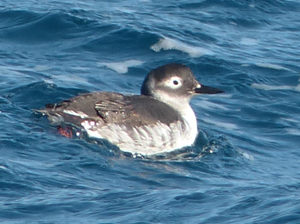
We will take a fishing boat out into the bay to get the best views of Ancient Murrelet, Rhinoceros Auklet and many of the aforementioned species as well as looking for the smaller numbers of Long-billed Murrelet, Brunnich’s Guillemot and Spectacled Guillemot. Given the right conditions the numbers of birds seen from the boat can be truly sensational and there is always the chance of a rarity. For those who suffer from seasickness most of these species can be found from the shore. If need be one guide can stay onshore and help those opting not to take the boat to find these seabirds.
Undisturbed beaches in this area offer the opportunity to see a real gull spectacular with huge numbers of them feeding on fish eggs washed up on the sand. Here we can pick out Mongolian Gulls from the crowd as well as perhaps more Glaucous-winged Gulls. In most years we can find the odd American Herring Gull among the large numbers of Vega, Black-tailed and Slaty-backed Gulls with Glaucous Gulls chasing other species from the best of the pickings. The sheer scale of numbers can be amazing and if a passing White-tailed Eagle puts the flock up it makes for a real spectacle.
Rocky bays usually provide us with good views of the lovely Harlequin Duck and we should be able to pick out a few Temminck’s Cormorants roosting on the rocks. Blue Rockthrush, Black-legged Kittiwake and small groups of Sanderling can usually be seen too.
On our second day we plan to conclude the day at a small riverside nature reserve at Gangneung where rafts of male Smew usually provide us with a view of them to remember. This location is also a good one in which to find Red-billed Starling on roadside wires or trees, Bull-headed Shrike, Oriental Greenfinch as well as wide range of ducks that we will have become familiar with by this point. The very mouth of the river is usually a reliable spot to find a few Long-billed Plovers or perhaps a Japanese Wagtail or two.
Day 8, Gangneung – Tabaeksan – Busan – 10th January 2025

We start the day by visiting a city park in Gangneung which may sound strange but the lake here is an excellent place to get really close views of species such as Smew, Northern Pintail, Goosander, Goldeneye as well as finding Greater Scaup. Trees around the area can contain Dusky Thrush, Hawfinch, Chinese Grosbeak and Naumann’s Thrush while in the undergrowth Siberian Accentor occurs. Olive-backed Pipit, Rustic Bunting and Yellow-throated Bunting are usually foraging on the ground and a nearby stream gives us another chance at Japanese Wagtail. Reedy areas may hold Black-faced Bunting or something rarer while adjoining fields are likely to have flocks of Oriental Skylark for us.
After a short morning here we will drive inland and uphill to a mountain ridge where cabbage fields and wooded areas provide the setting for a wind farm. The main reason for making the journey here is to search for a regular wintering flock of Asian Rosy Finches. These smart birds like to feed as a constantly moving, rolling flock on scraps of vegetation from decomposing cabbages. This is a seldom-visited area and it can turn up a surprise or two; on previous visits we have found Pallas’s Rosefinch, Bullfinch, Hazel Grouse and Snow Bunting here.
After enjoying our targets there is one of our longer journeys to make to the city of Busan, stopping for dinner along the way. We will then arrive at a nice hotel just a stone’s throw from our first birding stop of the next morning.
Day 9, Nakdong Estuary – Junam – 11th January 2025

Our day will start with a visit to the very nearby Nakdong Estuary, viewing the sand bars and mud from the city promenade. We are likely to see our first Saunders’s Gulls, elegantly flying along the water’s edge. There will also be plenty of the gulls that we have become familiar with by this time too. The real target, however, is Relict Gull. A few of these rare gulls spend the winter at the estuary and they are usually picking at food where the sand bars meet the water.
Wildfowl will include many familiar species such as Whooper Swan and Eurasian Wigeon and here we can add a few waders to our list including the osculans subspecies of Oystercatcher which is sometimes split as Far Eastern Oystercatcher. Grey Plover, Eurasian Curlew and Dunlin can usually be spotted too. Vegetation is at a minimum here but even so birds such as Daurian Redstart, Warbling (Japanese) White-eye and Pale Thrush can all turn up in the few bushes that occur. Raptors can feature well here with Steller’s Sea Eagle often seen at some distance as well as Eastern Marsh Harrier, Black-eared Kite and Western Osprey.
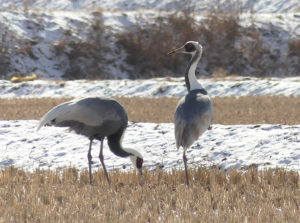
There are good birds to see here but by mid-morning we will move off towards Junam reservoir, a short journey, stopping for lunch along the way. Junam is a lovely birding site with a wide variety of species, many of which we can see very well at close range. Trees and farmland around the reservoir often host flocks of Dusky Thrushes and this is a really good location to catch up with Grey-headed Woodpecker. Eurasian Hoopoe winters here in small numbers and looks rather out of place if there is covering of snow! Species such as Brambling, Oriental Greenfinch, Hawfinch and Rustic Bunting are frequent as well as many of the commoner birds we will have seen along the way such as Daurian Redstart, Yellow-throated Bunting and Marsh Tit.
One of the highlights at Junam is an area of rice fields that attract large numbers of wildfowl and it is here that we usually get our closest views of handsome male Baikal Teal. This is one of our best chances of seeing Swan Goose too alongside both Tundra and Taiga Bean Geese. It is a real spectacle to watch flocks of Northern Pintail, Whooper Swan and Greater White-fronted Geese swoop in to feed in the damp fields and this is a good opportunity for photos. The stubble fields also hold flocks of White-naped Cranes and it is wonderful to watch them flying in and out.
The reservoir itself holds good numbers of wildfowl and it is worth scanning through them for rarities. Eurasian Spoonbill is usually present in good numbers and this is a good chance to find Oriental Stork too. While we are admiring all of these birds we must not forget to familiarize ourselves with White-cheeked Starling which is more abundant here than at any other site on this South Korea winter birding trip.
Day 10, Nakdong Estuary – Suncheon Bay – 12th January 2025

This morning there is a chance to look for Relict Gull again should we need to otherwise the plan is to visit the opposite side of the estuary and do our birding from a riverside park. Here we will see many of the same species but hope for much closer views of Saunders’s Gulls. Scanning the water always gives us a chance of finding something unusual and Eastern Marsh Harrier sometimes hunts for prey over the reeds. The riverside park itself has proven to be a good place to find smart Yellow-bellied Tits which seem to visit the Korean Peninsula more frequently than in the past.
We also plan a walk in a small forest park which in some years attracts some interesting migrants such as Red-flanked Bluetail or White’s Thrush. Perhaps this will be an influx year for Grey Bunting? Regularly occurring birds should include Pale Thrush and Japanese White-eye with many of the woodland birds that we have got to know along the way also being present; Japanese Pygmy Woodpecker and Marsh Tit to mention a couple. Korean Bush Warbler occurs here in small numbers even in winter so we will look out for this “little brown job” too. This woodland walk provides a change of scene from the wetland and open country birding over the last few days.
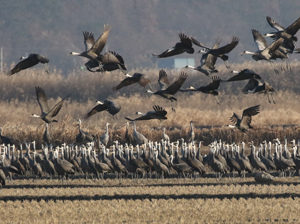
After some lunch we will head on towards Suncheon Bay where another amazing sight awaits us in the form of flocks of hundreds, if not thousands, of Hooded Cranes gathering to feed in stubble fields. These flocks usually contain a few Common Cranes as well as very small numbers of Sandhill Cranes, but the numbers of birds is again impressive. Groups of Greater White-fronted Geese feed alongside them and sometimes Lesser White-fronted Geese too. This can also be a good spot for raptors; on previous visits Upland and Rough-legged Buzzards have been seen while Hen Harrier and Eastern Buzzard can be expected.
Reed beds here provide a good opportunity to find Chinese Penduline Tit but as the afternoon draws to a close we will drive to Gunsan, arriving after dark in time to have dinner at a nearby restaurant.
Day 11, Guem Estuary – 13th January 2025
Using the city of Gunsan as our base we can spend the day exploring a variety of habitats that include rice fields, rivers, mudflats and bays. The fields should give us more opportunities to see flocks of Tunda and Taiga Bean Geese alongside Greater White-fronted Geese. This is also another opportunity to scan for Lesser White-fronted Goose among the flocks. The Guem river often holds a large flock of Baikal Teal and the sight of tens of thousands of these birds is incredible. Looking like an oil slick on the water it will be a sight to remember if they take flight!
Birding alongside the river we can find more buntings in the reeds including Black-faced Bunting, Yellow-throated Bunting and possibly something rarer. This is also a good spot to add Light-vented Bulbul to our trip list. Reeds alongside rivers always represent a chance to find good birds on this trip so if we are still looking for Pallas’s Reed Bunting or Long-tailed Rosefinch we can attempt to locate them here among flocks of Brambling and Rustic Bunting. If we are very lucky we could find Ochre-rumped Bunting.
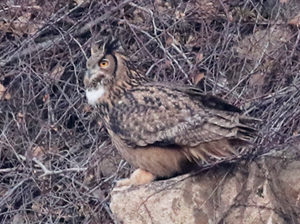
As the tide recedes in the coastal bays we hope to get really close-up views of the elegant Saunders’s Gull as well as having another chance, if needed, of finding the increasingly rare Relict Gull. Black-tailed, Heuglin’s, Vega and Black-headed Gulls are certain while in the surrounding vegetation we have more opportunities to see Japanese Pygmy Woodpecker, White-backed Woodpecker and Varied Tit. Exposed mudflats will provide us with views of Eurasian Curlews and it is worth spending a moment to scan through them to see if any Far Eastern Curlews are present. The area is also the winter home of large numbers of (Far Eastern) Oystercatchers and small groups of Swan Goose. On previous trips we have added common shorebirds such as Dunlin, Grey Plover, Kentish Plover and Common Greenshank to our South Korean lists here.
Areas of fields close to urban areas often play host to enormous numbers of (Oriental) Rook which loaf around on roof tops and power cables, the numbers being so concentrated as to create a real spectacle at times. Among these flocks we will make the effort to locate the few Daurian Jackdaws which typically accompany them. These fields also often host flocks of geese and raptors such as Peregrine Falcon, Hen Harrier and Eastern Buzzard.
There are lots of options in this area and we will spend our time in the places that offer us the best chances to find birds that are still eluding us or wish to have better views of. If we were not successful at Jeongok, earlier in the trip, we have another excellent chance to locate Eurasian Eagle Owl at an old quarry just outside of town.
Day 12, Gunsan – Seosan – Incheon Airport – 14th January 2025
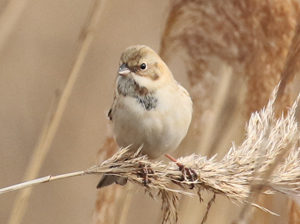
On this last day we will use our time to locate any species that we have not been successful with so far. Perhaps we will still be looking for Relict Gull, Oriental Stork, Chinese Grey Shrike or a big flock of Baikal Teal – there are options for all of these species. At some point during the day we plan to visit the reclamation lake and rice fields of Seosan where reed beds provide us with a good chance to see Pallas’s Reed Bunting alongside Common Reed Bunting. Perhaps we will be able to locate Chestnut-eared Bunting or one of the few Dusky Warblers that winter here.
If we have found all of our target species then we may well make another visit to Paldang to see Steller’s Sea Eagle again or perhaps chase a recently-found rarity somewhere along the way as we head back to our hotel near Incheon Airport. Here we will have a final dinner together and take a vote for bird of the trip, there will certainly be quite a few candidates.
Day 13, Departure from Incheon Airport – 15th January 2025
The hotel we stay in has a free shuttle service to the airport and everyone can choose a time most suitable to them from the timetable.
The following is a list of key species that we have a very good chance of finding based on the experience of previous visits. It is not meant as a complete list of birds that we will search for but they are some of the regional highlights that we will put effort into locating because they are memorable and/or have restricted ranges. While we expect to find a very high proportion of these birds we obviously cannot guarantee that we will see all of them; these are wild birds after all.
- Hazel Grouse – Tetrastes bonasia
- Swan Goose – Anser cygnoides
- Tundra Bean Gose – Anser serrirostris
- Taiga Bean Goose – Anser fabilis
- Lesser White-fronted Goose – Anser erythropus
- Mandarin Duck – Aix galericulata
- Falcated Duck – Anas falcata
- Eastern Spotbilled Duck – Anas zonorhyncha
- Baikal Teal – Anas formosa
- Harlequin Duck – Histrionicus histrionicus
- Stejneger’s Scoter – Melanitta stejnegeri
- Black Scoter – Melanitta americana
- Smew – Mergellus albellus
- Scaly-sided Merganser – Mergus squamatus
- Pacific Diver – Gavia pacifica
- Temminck’s Cormorant – Phalacrocorax capillatus
- Pelagic Cormorant – Phalacrocorax pelagicus
- White-tailed Sea Eagle – Haliaeetus albicilla
- Steller’s Sea Eagle – Haliaeetus pelagicus
- Cinereous Vulture – Aegypius monachus
- Hen Harrier – Circus cyaneus
- Sandhill Crane – Grus canadensis
- White-naped Crane – Grus vipio
- Hooded Crane – Grus monacha
- Red-crowned Crane – Grus japonensis
- Long-billed Plover – Charadrius placidus
- Solitary Snipe – Gallinago solitaria
- Black-tailed Gull – Larus crassirostris
- Glaucous-winged Gull – Larus glaucescens
- Vega Gull – Larus vegae
- Mongolian Gull – Larus mongolicus
- Slaty-backed Gull – Larus schistisagus
- Heuglin’s Gull – Larus heuglini
- Relict Gull – Ichthyaetus relictus
- Saunders’s Gull – Chroicocephalus saundersi
- Brunnich’s Guillemot – Uria lomvia
- Spectacled Guillemot – Cepphus carbo
- Long-billed Murrelet – Brachyramphus perdix
- Ancient Murrelet – Synthliboramphus antiquus
- Rhinoceros Auklet – Cerorhinca monocerata
- Eurasian Eagle Owl – Bubo bubo
- Japanese Pygmy Woodpecker – Yungipicus kizuki
- White-backed Woodpecker – Dendrocopos leucotos
- Black Woodpecker – Dryocopus javensis
- Grey-headed Woodpecker – Picus canus
- Bull-headed Shrike – Lanius bucephalus
- Chinese Grey Shrike – Lanius sphenocercus
- Azure-winged Magpie – Cyanopica cyanus
- Daurian Jackdaw – Coloeus dauuricus
- Eastern Great Tit – Parus minor
- Yellow-bellied Tit – Parus holsti
- Varied Tit – Poecile varius
- Chinese Penduline Tit – Remiz consobrinus
- (Japanese) Eurasian Skylak – Alauda arvensis (japonica)
- Chinese (Light-vented) Bulbul – Pycnonotus sinensis
- Brown-eared Bulbul – Microscelis amaurotis
- Manchurian (Korean) Bush Warbler – Cettia canturians (canturians)
- Vinous-throated Parrotbill – Paradoxornis webbianus
- (Asian) Goldcrest – Regulus regulus (japonensis)
- Red-billed Starling – Sturnus sericeus
- White-cheeked Starling – Sturnus cineraceus
- Pale Thrush – Turdus pallidus
- Naumann’s Thrush – Turdus naumanni
- Dusky Thrush – Turdus eunomus
- Red-flanked Bluetail – Luscinia cyanura
- Daurian Redstart – Phoenicurus auroreus
- Siberian Accentor – Prunella montanella
- Japanese Wagtail – Motacilla grandis
- Buff-bellied Pipit – Anthus rubescens
- Brambling – Fringilla montifringilla
- Grey-capped (Oriental) Greenfinch – Carduelis sinica
- Asian Rosy Finch – Leucosticte arctoa
- Long-tailed Rosefinch – Uragus sibiricus
- Pallas’s Rosefinch – Carpodacus roseus
- Hawfinch – Coccothraustes coccothraustes
- Chinese Grosbeak – Euphona migratoria
- Meadow Bunting – Emberiza cioides
- Rustic Bunting – Emberiza rustica
- Yellow-throated (Elegant) Bunting – Emberiza chrysophrys
- Black-faced Bunting – Emberiza spodocephala
- Pallas’s Reed Bunting – Emberiza pallasi
The map of South Korea below displays the main locations visited on this birding tour. Depending on local knowledge at the time there may be other sites visited as substitutes for these. On this tour the weather often dictates the order in which we visit these locations so some changes are likely.

1. Incheon International Airport
5. Paldang
9. Gangneung
13. Suncheon Bay
2. National Arboretum
6. Namhansanseong
10. Tabaeksan
14. Gunsan
3. Jeongok
7. Yangyang
11. Nakdong Estuary (Busan)
15. Seosan
4. Cheorwon
8. Daejin
12. Junam Reservoir
The following is a selection of the winter birds of South Korea photographed at sites visited on this tour.

Hooded Crane 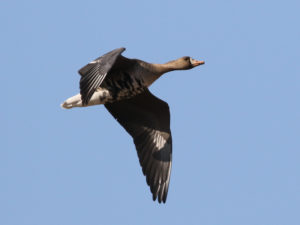
Greater White-fronted Goose 
White-backed Woodpecker 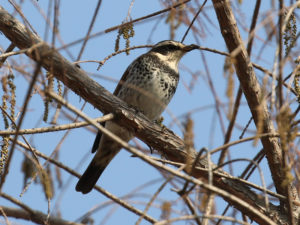
Dusky Thrush 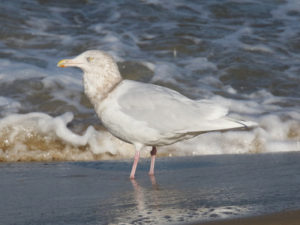
Glaucous Gull 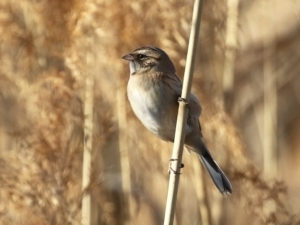
Ochre-rumped Bunting 
Red-crowned Crane 
Brown-eared Bulbul 
Black-tailed Gull 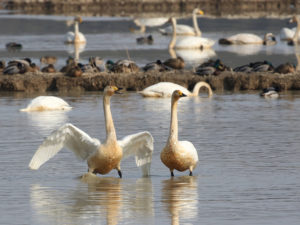
Whooper Swan 
Daurian Jackdaw 
Marsh Tit
All above photographs copyright Nick Upton/Calidris Birding Tours.
Tour Details
Tour Cost: £3950 per person
Single supplement: There isn’t one. Twin rooms are not available so all participants get a single room. Couples can share as the beds are very large and a small discount is available to couples in this instance. Please inquire for details.
Included in the tour cost: All transport including airport transfers, road tolls, entry fees, accommodation including on the night preceding the tour and on the last day of the tour, all meals, water, boat trip, services of English-speaking birding guide, translator and Calidris Birding Tours guide.
Not included in the tour cost; International flights, travel insurance, visa (most nationalities get visa-free entry), alcoholic drinks, tips, laundry and any other items of a personal nature.
Accommodation: All accommodation is convenient for accessing the birding sites and making travel logistics as simple as possible. Most accommodation is in very comfortable motels with private bathroom and toilet, hot shower, underfloor heating, hot drinking water, coffee/tea and TV. Good Wifi connections are available at all locations. In Daejin we stay in a very comfortable, small and homely hotel with a very hospitable owner and all the above facilities in the rooms.
Weather: Mid-winter weather in South Korea is cold. Generally it is bright and dry but there can be snowfalls at any time. Most day time temperatures will be between -5C and +10C but at certain locations it can be as cold as -20C. South Korea is very well set up to deal with these temperatures with hot drinks widely available, efficient heating in all buildings and effective heaters in vehicles.
Food: Generally breakfasts will consist of various bread products along with hot coffee. At our hotel on the north east coast fried eggs, toast and cheese is available. Lunches are either light picnic lunches or hot, traditional Korean dishes. Evening meals are always traditional Korean cuisine, eaten in warm restaurants. Korean food is usually meat or fish based and varies between rice, noodle or stew/soup dishes. Vegetarian food is not widely eaten in Korea but our local guide is a vegetarian so that this requirement can be catered for. Please inform us of any special eating requirements, including any food allergies, you may have in advance.
Tour Leaders
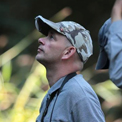
Nick Upton
Nick Upton has been birding since the age of seven and leading birding tours full-time since 2007. After travelling extensively in Asia he settled in Thailand in 1997, teaching English and science while establishing thaibirding.com. With a BSc (Hons) Wildlife & Countryside Conservation he is well placed to understand the ecology and conservation issues that affect birds as well as being adept at finding them.
Nick is co-founder/director of Calidris Birding Tours.
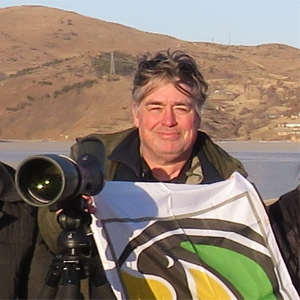
Dr Nial Moores
Nial Moores is the pre-eminent birder and ornithologist in the Republic of Korea. Having been birding in East Asia since 1990 and settled in South Korea since 1998 he is a rare combination of an excellent birder with an unparalleled knowledge of bird ecology. With a PhD in Avian Conservation in the Yellow Sea, Nial is not only an asset as a guide but a font of knowledge while birding.
Nial is co-founder of Birds Korea.
While we will make every effort to adhere to the advertised itinerary of this South Korea winter birding tour, we reserve the right to make changes in the case of unforeseen circumstances that are beyond our control. These include problems with accessibility, national park closures, unseasonal weather events or any other reason that may demand an itinerary change.
Recommended Field Guide
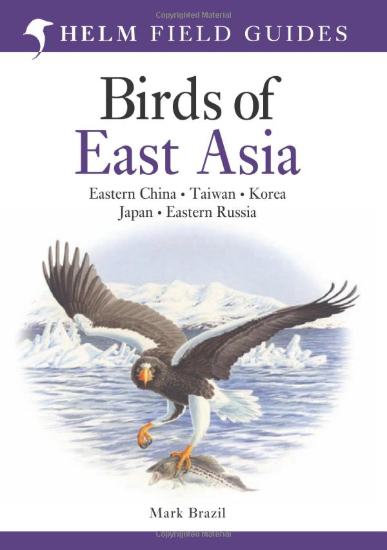 Birds of East Asia
Birds of East Asia
In the absence of any English-language field guide specifically for the Korean peninsula this publication contains all of the species we are likely to see on this South Korea winter birding tour. We recommend that participants on this tour obtain a copy of this field guide well in advance of the tour commencing to familiarize themselves with the species we can potentially see.
The checklist that Calidris Birding Tours will issue for this trip will use IOC taxonomy with reference to the taxonomy used within this field guide so that it is relevant to both.
Read our full review of the book here – Birds of East Asia.
Trip Reports
South Korea Winter Birding Trip Report January 2023
Videos
White-naped Crane Call; Trumpeting Flocks in South Korea
The flock of White-naped Cranes in full trumpeting mode at Junam Reservoir creates one of the most memorable soundscapes of our South Korea winter birding tour. With cranes to the front of you, cranes to the left and cranes to the right, as well as overhead, this encounter is like an avian Charge of the Light Brigade. This is an extremely memorable birding experience and one not to be missed. When watching the video look out for small numbers of Hooded Crane as well as a couple of Sandhill Cranes.
Watch the video – White-naped Cranes.
This is what Half a Million Baikal Teal look like
Almost the entire world population of Baikal Teal winter close to the South Korean town of Gunsan and, congregating in one massive flock, they create one of the most amazing spectacles in birding. Standing on the bank of the Guem river in the late afternoon vast numbers of Baikal Teal assemble, often in a rolling flock, before they all take off and head out to stubble fields where they feed at night.
Watch the video – Baikal Teal Flock.
Photo Galleries
South Korea Winter Birds Photo Gallery January 2023
Related Blog Posts
- Pre-Trip Birding Around Incheon – posted by Nick Upton 05/06/23
- Winter Woodpeckers of Korea – posted by Nick Upton 09/05/19
- Becoming a Gull-Watcher in Winter – posted by Nick Upton 23/01/19
- Winter Wildfowl – posted by Nick Upton 18/01/19
- Western Gull: Second Record for Korea & Perhaps East Asia – posted by Dr Nial Moores 18/02/17
- East Coast Gulls – posted by Nick Upton 30/01/17
- Cranes in the Citizen Controlled Zone – posted by Nick Upton 22/01/17
- National Arboretum – posted by Nick Upton 21/01/17
Terms and conditions: Please read full Calidris Birding Tours terms and conditions which apply to the South Korea Winter Birding Tour.

